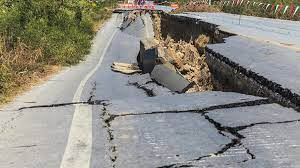Causes and effect of Earthquake
Earthquakes are one of the most devastating natural disasters that can strike at any time and place, without warning. An earthquake is a sudden movement of the Earth's crust caused by the release of built-up stress in the Earth's lithosphere. Earthquakes can cause widespread damage and loss of life, and they are a major threat to communities around the world. In this article, we will explore the causes of earthquakes, their effects on the environment and human populations, and what can be done to mitigate their impacts.
What Causes Earthquakes?
The Earth's crust is composed of large plates that float on the molten mantle below. These plates can move in different directions and sometimes collide with each other, creating areas of high stress. When the stress becomes too great, the plates can suddenly slip, releasing energy in the form of seismic waves that cause the ground to shake.
There are two main types of earthquakes: tectonic and volcanic. Tectonic earthquakes occur when two plates grind against each other, creating a build-up of stress that is eventually released. Volcanic earthquakes occur when magma rises to the surface and causes the ground to shake.
Earthquakes can also be triggered by human activities such as the construction of large dams, underground mining, and the pumping of fluids into the ground. These man-made earthquakes are known as "induced earthquakes" and can be just as damaging as natural earthquakes.
Effects of Earthquakes on the Environment and Human Populations
The effects of earthquakes on the environment and human populations can be devastating. Strong earthquakes can cause widespread damage to buildings and infrastructure, leading to the collapse of homes, roads, bridges, and other structures. Earthquakes can also trigger landslides and tsunamis, which can cause further damage and loss of life.
In addition to the immediate physical effects, earthquakes can also have long-term economic and social impacts. For example, the destruction of homes and businesses can lead to widespread displacement and loss of income, while the disruption of critical infrastructure such as water and power supplies can have a major impact on communities for months or even years after the event.
What Can Be Done to Mitigate the Impacts of Earthquakes?
There are a number of measures that can be taken to mitigate the impacts of earthquakes. These include:
Improved Building Codes: Building codes can be revised to ensure that buildings are constructed to withstand earthquakes. This includes the use of reinforced concrete and steel frames, as well as the implementation of seismic isolation and energy dissipation systems.
Early Warning Systems: Early warning systems can provide valuable seconds or minutes of warning before an earthquake strikes, allowing people to evacuate buildings and seek safety.
Disaster Preparedness Planning: Communities can develop disaster preparedness plans to help reduce the impacts of earthquakes. This includes preparing evacuation plans, stocking emergency supplies, and establishing communication systems to respond to the disaster.
Improved Land-Use Planning: Land-use planning can help reduce the impacts of earthquakes by avoiding the development of high-risk areas, such as those prone to landslides, and by guiding development away from areas that are most vulnerable to damage.
Conclusion
Earthquakes are a major threat to communities around the world, and their impacts can be devastating. However, by understanding the causes of earthquakes and implementing measures to mitigate their impacts, we can help reduce the risk to human populations and the environment. Whether through improved building codes, early warning systems, disaster preparedness planning, or improved land-use planning, there are many ways to make communities more resilient in the face of earthquakes.





Comments
Post a Comment